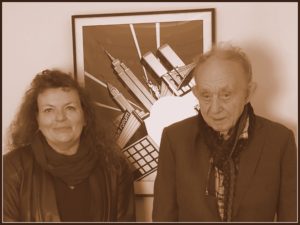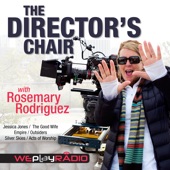Click to tweet this interview to your friends and followers!
“I’m endlessly interested in live cinema.”
— Sam Green
In early December of 2018, I spoke with filmmaker Sam Green about his new project A Thousand Thoughts. Green performs a live (poignant and often very funny ‘voiceover’) narration on stage throughout the 85-minute piece alongside the Kronos Quartet, who are also performing live on stage and often alongside images of themselves.
Kronos Quartet violinist David Harrington describes the work as “a live documentary”—a film, a concert and lecture.
A Thousand Thoughts is a unique and powerful experience that is not limited to an audience of music lovers or just fans of the Kronos Quartet; its themes are universal and its presentation, captivating.
ABOUT A THOUSAND THOUGHTS
Academy Award®-nominated filmmaker Sam Green (The Weather Underground), in collaboration with Emmy Award®-winning writer and editor Joe Bini (Roman Polanski: Wanted and Desired, Grizzly Man), takes the stage with the legendary classical-music group, Kronos Quartet, to create a “live documentary” that chronologically unfolds the quartet’s groundbreaking, continent-spanning, multi-decade career.
Wildly creative and experimental in form, A Thousand Thoughts is a meditation on music itself-the act of listening closely to music, the experience of feeling music deeply, and the power that music has to change the world.
Green narrates the piece live onstage while the Kronos Quartet performs the score, and a rich blend of archival footage, photos, and interviews with members of the Kronos Quartet—as well as longtime collaborators like Philip Glass, Laurie Anderson, Terry Riley, Tanya Tagaq, Steve Reich—unspools on screen. After premiering at the 2018 Sundance Film Festival, A Thousand Thoughts screened at the National Opera House in Athens, Greece, and is touring nationally. It received the Audience Award for Best Documentary at the 2018 San Francisco International Film Festival.
ABOUT THE FILMMAKERS
Director, Writer, Editor Sam Green is a New York-based documentary filmmaker. He received his master’s degree in Journalism from University of California Berkeley, where he studied documentary with acclaimed filmmaker Marlon Riggs. Green’s most recent live documentaries include The Measure of All Things (2014), The Love Song of R. Buckminster Fuller (with Yo La Tengo) (2012), and Utopia in Four Movements (2010). With all of these works, Green narrates the film in-person while musicians perform a live soundtrack. Green’s 2004 feature-length film, The Weather Underground, premiered at the Sundance Film Festival, was nominated for an Academy Award, included in the Whitney Biennial, and has screened widely around the world.
Director, Writer, Editor Joe Bini is best known for his long-time collaboration with Werner Herzog. Their work together is comprised of over 20 films in all, including the narrative films Rescue Dawn and The Bad Lieutenant: Port of Call New Orleans and such notable documentaries as Little Dieter Needs to Fly, Grizzly Man, Cave of Forgotten Dreams, Into the Abyss, and the 2015 drama, Queen of the Desert. Roman Polanski: Wanted and Desired, a film that Bini cut and co-wrote, won the Documentary Film Editing Award at the 2008 Sundance Film Festival and an Emmy Award for Outstanding Nonfiction Writing. He won the Prix Vulcain De L’Artiste-Technicien at the 2010 Cannes Film Festival for We Need to Talk About Kevin.
ABOUT THE KRONOS QUARTET
For more than 40 years, San Francisco’s Kronos Quartet—David Harrington (violin), John Sherba (violin), Hank Dutt (viola), and Sunny Yang (cello)—has combined a spirit of fearless exploration with a commitment to continually reimagine the string quartet experience. In the process, Kronos has become one of the world’s most celebrated and influential ensembles, performing thousands of concerts, releasing more than 60 recordings, collaborating with many of the world’s most intriguing and accomplished composers and performers, and commissioning over 900 works and arrangements for string quartet. Kronos has received over 40 awards, including the Polar Music and Avery Fisher Prizes, two of the most prestigious awards given to musicians.
THE INTERVIEW
The filmmakers had extensive archival material from which to work, as well as the Kronos Quartet themselves and its former members. During the film, filmmaker Chantal Ackerman’s News from Home (the 1977 avant-garde documentary) is referenced, and how this work captured America unraveling during this era; this reference underscored the historical context that coincided with the 40 years of the Kronos Quartet’s existence and how the history of the past four decades are an integral part of the evolution of the Kronos Quartet as musicians, as well as the music they perform and commission.
KOUGUELL: In A Thousand Pieces you discussed the definition of documentary, and what this film is and isn’t. Please expand on this.
GREEN: There are many different types of documentaries and some subjects are permanent and never changing. There are many reasons I thought the live format would work for this project; experiencing it in person is a completely different thing than just including recorded music.
I generally don’t like music documentaries because they’re so formulaic. Like the “Behind the Music” types; they’re predictable and what I don’t like in that is it’s just a little bit of music, and the music fits into it. (Green laughs) And Kronos was not trashing hotel rooms in the 70s.
In a normal documentary, when you have three minutes of music it’s way too long. In the live format there are no rules, so this form is well-suited, and music is at the heart of it. The live experience is unique and in some ways the form reflects it.
KOUGUELL: How many times have you presented A Thousand Pieces?
GREEN: To date, this project has been performed 15 times. We have fine-tuned things; some small changes. Every show is different based on the size of the room, the time of day, is the audience drinking alcohol, and so on. There are a million intangible things that I like a lot.
KOUGUELL: Let’s talk about your collaborations with Joe Bini and Kirsten Johnson, and the collaboration with the Kronos quartet.
GREEN: Cinematographer Kirsten Johnson and I are old friends. I was floored by her documentary Cameraperson—the sensibility behind it, it was so wise and insightful, and I knew I had to have her on this project.
Joe and I met at a Sundance event, and he was so smart and radical, and we became friends. The editing was challenging and complicated. My collaboration with Joe was one of the best I’ve ever had.
Working with Kronos was great, we interviewed them, and showed them the film at the end.
KOUGUELL: In the film, you mentioned that this film was an “unauthorized biography” of the Kronos Quartet. What was the reaction of the project by the Kronos?
GREEN: We had no rules about what we could include or not include in the documentary. There were some small things they didn’t like; the bigger things like when Harrington talked about losing his son, the quartet doesn’t like sitting through that, they rather not be in that, but they recognize that it’s a big element that evokes something deep and complex.
KOUGUELL: Let’s talk about the writing process and script.
GREEN: We started with the music and created scenes from around the music and pieced together a story. Joe and I wrote the story, we pieced it together with words, images and music. It’s a tech-based piece, and it is a script, and I’ve memorized it.
A funny thing: I’ve never been able to write with someone else, but while Joe and I were working, I said I’d work alone with the first section and he gave me a weird look, and suggested we try it together. It totally worked! I asked him, ‘How do you know how to write voice-over?” and Joe laughed and said: “I worked with Werner Herzog for years.”
Find A Thousand Thoughts upcoming events here.






























 Rodriguez: The film opened in September 2016 in a limited theatrical run, playing eight weeks in Palm Springs and eight weeks at The Villages in Florida. We played in Orange County, Arizona and around Florida. Little by little, it’s kept going. We are finishing our theatrical run March 30.
Rodriguez: The film opened in September 2016 in a limited theatrical run, playing eight weeks in Palm Springs and eight weeks at The Villages in Florida. We played in Orange County, Arizona and around Florida. Little by little, it’s kept going. We are finishing our theatrical run March 30.

 Kouguell: We’ve spoken a great deal about your love of collaboration. Your Podcast ‘The Director’s Chair’ available on iTunes, has welcomed writers, producers, directors, and actors, including Jessica Jones star Krysten Ritter, to discuss collaborating.
Kouguell: We’ve spoken a great deal about your love of collaboration. Your Podcast ‘The Director’s Chair’ available on iTunes, has welcomed writers, producers, directors, and actors, including Jessica Jones star Krysten Ritter, to discuss collaborating.


